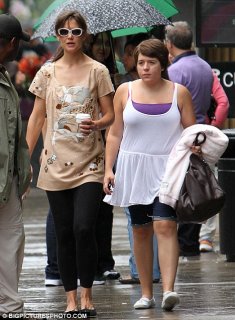Oh. My. God. Look at this dress! It’s so Cyd Charisse,” Jeanne Yang gasps, as she yanks a gauzy white knee-length polyester number, its flouncy skirt and belled sleeves adorned with white feathers and silver fringe, from a crowded rack. “Tell me she didn’t wear this.”
Katie Holmes, the other half of Holmes & Yang, the fashion label founded in 2008, studies the baroque garment and announces: “You could not eat or drink in this dress.” (She’s right, unless you’re a fan of fringe in your food.)
It’s a rainy April morning, and Holmes and Yang are scouring West Hollywood’s Palace Costume, a massive clothing archive (there are rooms devoted entirely to American Old West attire and Depression-era clothing), to find inspiration for their spring 2011 collection. Poised and polite, Holmes wears dark skinny jeans and navy flats; a black bra winks beneath her sheer gray shirt, and an electric blue Hermès Kelly bag dangles from her arm. It’s a casual, if cheeky, take on the elegant, glam style she’s adopted in recent years, evolving from a sweet, midriff-baring WB starlet into one of the most famous women in the world, with an increasingly polished look (the bob, the Victoria Beckham sunglasses)—not to mention a marriage—that garners as much attention as her work. (At press time, Holmes had just been chosen to play Jackie O. in the History Channel miniseries The Kennedys; the resemblance seems as much sartorial as physical.) Turns out, several of Holmes’ most commented-upon getups—the navy leather halter and silk pencil skirt she wore to the Tropic Thunder premiere; the sui generis cream-colored silk jumpsuit and black lace top she donned for an All My Sons after-party—were, in fact, early Holmes & Yang creations.
The two women met six years ago on a photo shoot, where Yang, now 40, was the stylist, and Holmes, 31, the subject. (Also among Yang’s high-flying clientele: Brad Pitt, George Clooney, Eva Mendes.) They bonded over a mutual outrage; both were miffed that the pockets on a pair of Holmes’ white pants were visible through the fabric. “She said, ‘Why didn’t they put a nude lining in?’ ” says Yang, who has a warm, take-charge demeanor. “I thought, That’s crazy that she would notice that. This wasn’t just an appreciation of pretty clothes.” Four years later, while sitting “in Kate’s closet,” as Yang tells it, the pair shared another lament: “How unfair is it that guys have a uniform?” They set out to simplify dressing for women, too. “We want to create pieces a woman can wear over and over, and people won’t necessarily say, ‘Oh, you wore that last week,’ ” says Holmes. (A significant concern when you’re the heavily photographed Mrs. Tom Cruise.)
Yang calls their designs “classics with a twist.” The spangled Cyd Charisse frock they’ve found at Palace Costume is all twist, not enough classic—far too fussy for the Holmes & Yang aesthetic, which is tailored yet easygoing, down-to-earth yet exceedingly high-end. Each item is pared down but not plain, basic without being boring: that perfect blouse, trousers, jumpsuit, skirt, or cocktail dress, all made of silk (jersey, crepe de chine, or jacquard) in neutral colors, with a bit of leather (on biker jackets and employed as trim) thrown in for a hint of toughness. It’s elegant, flattering clothing in the grown-up, classy-sexy vein of Phoebe Philo’s Céline. If you were suddenly forced to pack a suitcase and walk away from your life—or just your closet—a few Holmes & Yang pieces would cover all the necessary bases. Of course, a few may be all you can afford; the designers attribute their price point ($2,375 for a cocktail dress, $945 for a blouse) to their commitment to luxury fabrics, to the fact that their clothes are produced in New York City’s garment district, and to details like silk linings and hand-sewn zippers.
The fall 2010 collection, which hit stores in June, has its roots in the designers’ mutual love of dance. (Holmes still takes classes four times a week.) “Ballet is superclassic, and there are so many rules,” Yang says. “But you’ve got to have a little rebellion…you can always tell a dancer by the way she puts her clothes together.” The duo hewed to a strict palette of black, cream, and that distinct shade of ballet nude-pink. There are knit leg warmers and plenty of sexy nude-and-black pieces (standouts include a striped ’70s-era maxidress and a tight ruched column in nude silk overlaid with Chantilly lace) that evoke a dancer’s stylish, unstudied ease.
Neither designer has formal fashion training, but both learned to sew as young girls. Yang’s mother, who immigrated to the U.S. from Korea, owned a Los Angeles factory that produced jeans for brands such as the Limited and Express. Holmes’ mother, Kathleen, who had five children and her own drapery business in Toledo, Ohio, “sewed every curtain, every pillow,” Holmes says. “My sisters and I would sketch outfits all the time for fun.” These days, Holmes and Yang do all their own sketching, faxing each other edits when they find themselves in different cities, as they often do.
Perhaps the most unique (some might say bizarre) twist of Holmes & Yang is that it also includes pieces for young girls that coordinate with, and occasionally outright match, the ones created for Mom. Yang’s seven-year-old twins, Sydney and Zoey, and celebri-tot Suri, four, the world’s tiniest fashionista, serve as muses. To those who would scoff at dressing like one’s kid, Holmes has a sweet, openhearted response: “They love matching Mom. And it’s a limited time during which they really want to.” She also insists that the philosophy behind the little girls’ clothes is “very practical”: “What twirls, what doesn’t itch, and what’s pretty.”
So practical, in fact, that now the men in their lives—Yang’s husband, Scott Cort, who works in real estate, and Cruise, of course—want in. “They always hang out at our meetings,” Holmes says.“They say, ‘When are you guys going to do the men’s collection?’ ”










 ..it was almost universally derided in the tabloids when she showed up in that monstrosity...
..it was almost universally derided in the tabloids when she showed up in that monstrosity...
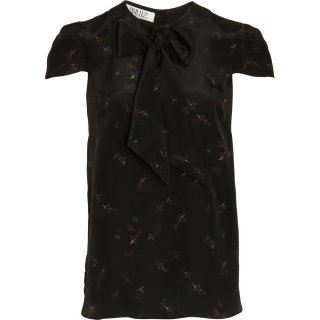
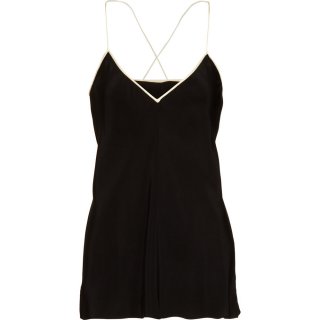
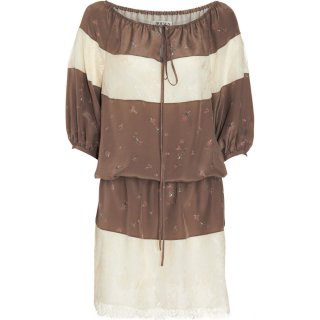
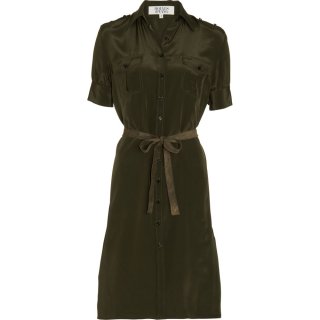
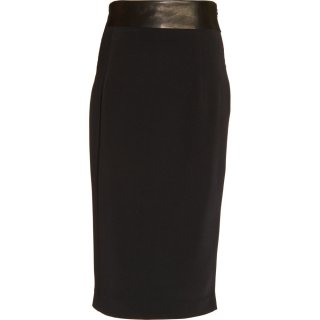
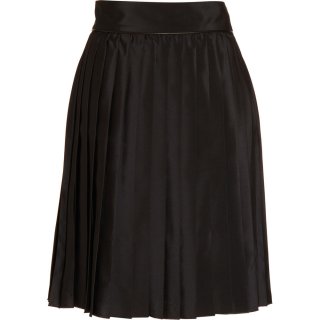
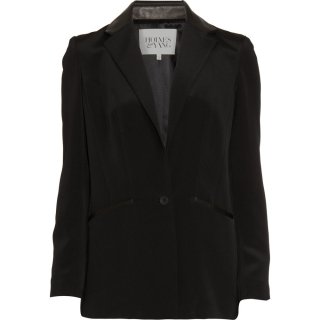
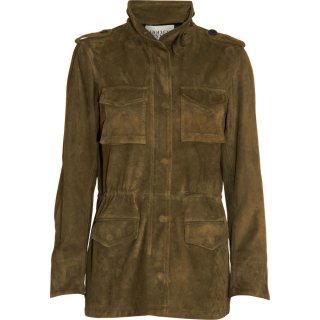
 The pieces look well-made, I like that they're made in the US ... but I've not been tempted to try anything on. The pieces seem to be a bit too basic, and not crazy about their choice of accent colors. I do like the basic idea though of things that are not so memorable that people clock you wearing them again. Not crazy about the leather trim. I do find the built-in Spanx interesting ...
The pieces look well-made, I like that they're made in the US ... but I've not been tempted to try anything on. The pieces seem to be a bit too basic, and not crazy about their choice of accent colors. I do like the basic idea though of things that are not so memorable that people clock you wearing them again. Not crazy about the leather trim. I do find the built-in Spanx interesting ...